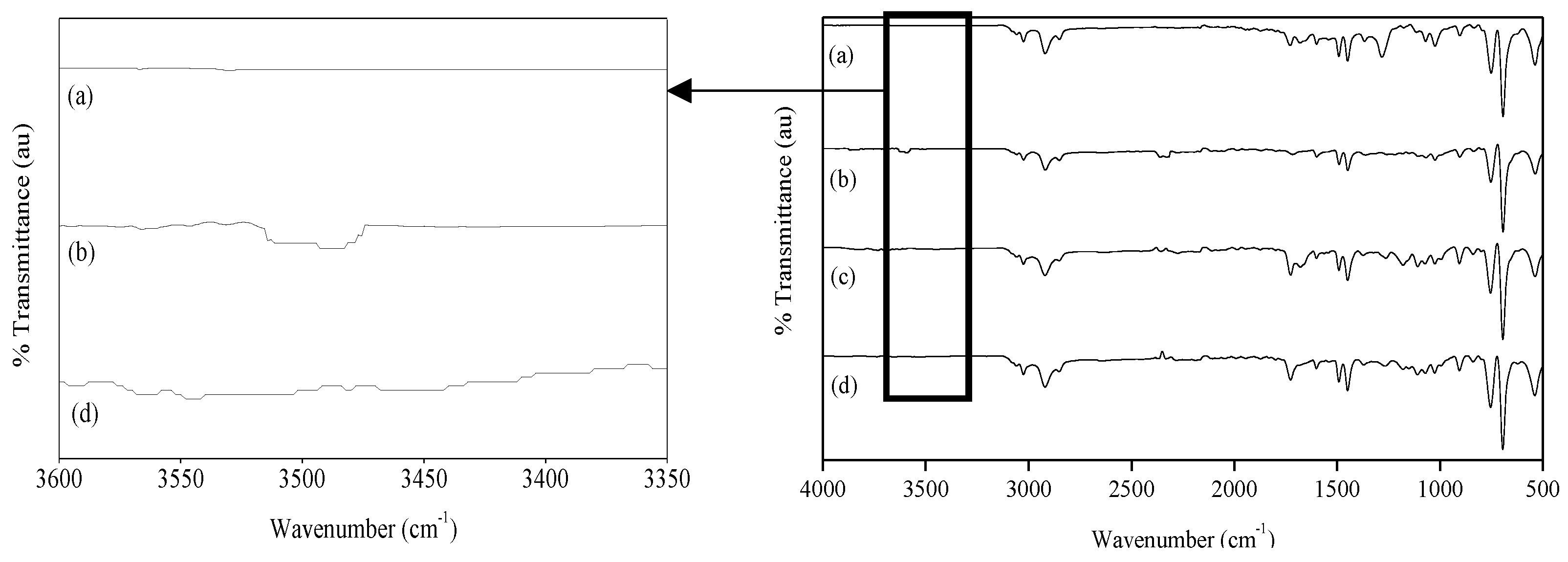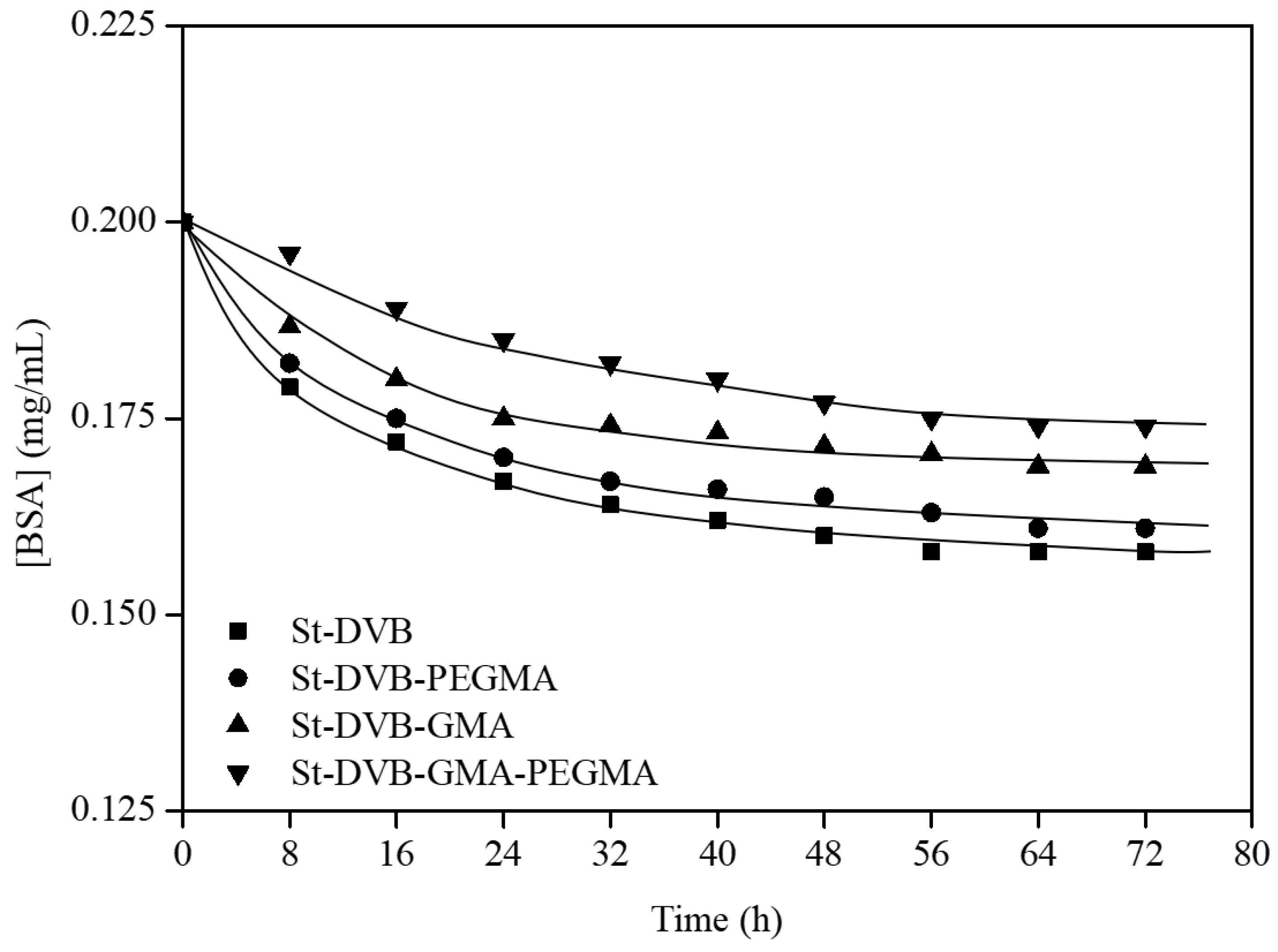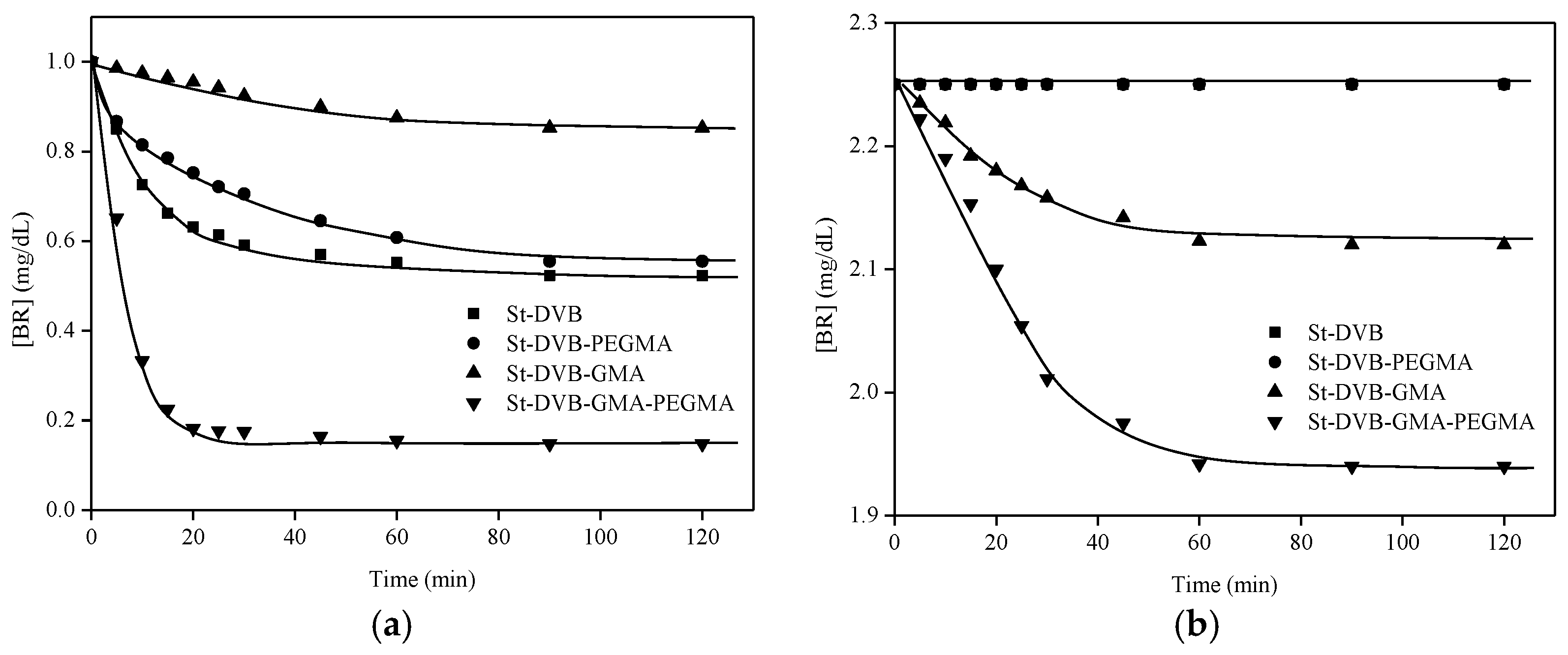Crosslinked Bifunctional Particles for the Removal of Bilirubin in Hyperbilirubinemia Cases
Abstract
:1. Introduction
2. Materials and Methods
2.1. Materials
2.2. Methods
2.2.1. Synthesis of Polymeric Particles
2.2.2. Albumin Immobilization
2.2.3. Bilirubin Removal
2.3. Characterization of Polymers
2.3.1. Scanning Electron Microscopy
2.3.2. Particle Size and Polydispersity Index
2.3.3. Fourier Transform Infrared Spectroscopy (FT-IR)
2.3.4. Epoxide Content
2.3.5. Protein Concentration Determination
2.3.6. Bilirubin Concentration Determination
3. Results
3.1. St-DVB Functionalized Particle Synthesis
3.2. BSA Immobilization
3.3. Bilirubin Removal Tests
4. Conclusions
Author Contributions
Funding
Institutional Review Board Statement
Informed Consent Statement
Data Availability Statement
Acknowledgments
Conflicts of Interest
References
- Bernal, W.; Auzinger, G.; Dhawan, A.; Wendon, J. Acute liver failure. Lancet 2010, 376, 190–201. [Google Scholar] [CrossRef] [PubMed]
- Nguyen, A.; Mirza, S.; Javed, N.; Hanif, H.; Ryu, M.; Mirza, R.T.; Sheikh, A.B. Extracorporeal Liver Support: An Updated Review of Mechanisms and Current Literature. J. Community Hosp. Intern. Med. Perspect. 2022, 12, 44–49. [Google Scholar] [CrossRef] [PubMed]
- Carvajal, C.C. Bilirrubina: Metabolismo, pruebas de laboratorio e hiperbilirrubinemia. Med. Leg. Costa Rica 2019, 36, 73–83. [Google Scholar]
- Hansen, T.W.R. Biology of Bilirubin Photoisomers. Clin. Perinatol. 2016, 43, 277–290. [Google Scholar] [CrossRef]
- Qian, S.; Kumar, P.; Testai, F.D. Bilirubin Encephalopathy. Curr. Neurol. Neurosci. Rep. 2022, 22, 343–353. [Google Scholar] [CrossRef]
- Rivera, M.; Liaño, F.; Tenorio, M.T. Diálisis en el paciente con hepatopatía crónica. Nefrología 2013, 4, 16–21. [Google Scholar]
- Catalina-Rodríguez, M.V.; Bañares-Cañizares, R. Sistemas de soporte hepático artificial: Estado actual del tratamiento con diálisis de albúmina (MARS). Gastroenterol. Hepatol. 2005, 28, 453–460. [Google Scholar] [CrossRef]
- Yoo, S.W.; Ki, M.J.; Kim, D.; Kim, S.K.; Park, S.; Han, H.J.; Lee, H.B. Bleeding complications associated with the molecular adsorbent recirculating system: A retrospective study. Acute Crit. Care 2021, 36, 322–331. [Google Scholar] [CrossRef]
- Peng, Y.; Feng, X.; Jiang, J.; Ren, L. Controllable polyvinylpyrrolidone modified Polystyrene divinylbenzene for efficient adsorption of bilirubin and improvement of hemocompatibility. Eur. Polym. J. 2022, 170, 111172. [Google Scholar] [CrossRef]
- Yang, K.; Peng, Y.; Wang, L.; Ren, L. Polymyxin B engineered polystyrene-divinylbenzene microspheres for the adsorption of bilirubin and endotoxin. RSC Adv. 2021, 11, 39978–39984. [Google Scholar] [CrossRef]
- Griveau, L.; Delorme, J.; Engstroöm, J.; Dugas, P.Y.; Carlmark, A.; Malmstroöm, E.; D’Agosto, F.; Lansalot, M. Synergetic Effect of Water-Soluble PEG-Based Macromonomers and Cellulose Nanocrystals for the Stabilization of PMMA Latexes by Surfactant-Free Emulsion Polymerization. Biomacromolecules 2020, 21, 4479–4491. [Google Scholar] [CrossRef] [PubMed]
- Jiang, X.; Xiang, T.; Xie, Y.; Wang, R.; Zhao, W.; Sun, S.; Zhao, C.S. Functional polyethersulfone particles for the removal of bilirubin. J. Mater. Sci. Mater. Med. 2016, 27, 28. [Google Scholar] [CrossRef] [PubMed]
- Francisco, R.R.J.; De Lucas Martinez, A.; Salvador, C.F.M.; María, B.S.A.; Javier, R.C.F.; David, P.V.; Del Prado, G.M.M. Partículas Funcionalizadas Ligantes de Proteínas, Métodos de Obtención y Cartuchos de Diálisis que Contienen Dichas Partículas. Oficina Española de Patentes y Marcas. Patent ES2691146B2, 17 May 2019. [Google Scholar]
- Garrido, M.D.P.; Borreguero, A.M.; Redondo, F.J.; Padilla, D.; Carmona, M.; Ramos, M.J.; Rodriguez, J.F. Functionalization of Poly(styrene-co-methyl methacrylate) Particles for Selective Removal of Bilirubin. Materials 2022, 15, 5989. [Google Scholar] [CrossRef]
- Lozano, M.J.S.; Cid, J.L.-H.; Barrezueta, L.B.; Hofheinz, S.B. Protocolo de Técnicas de Depuración Extrarrenal; SECIP: Barcelona, Spain, 2020. [Google Scholar]
- UNE-EN ISO 3001; Plásticos; Compuestos Epoxídicos; Determinación del Equivalente Epoxídico. AENOR: Madrid, Spain, 2000.
- Waterborg, J.H. The Lowry method for protein quantitation. In The Protein Protocols Handbook; Springer: Berlin/Heidelberg, Germany, 2009; pp. 7–10. [Google Scholar]
- Costa, E.; Calleja, G.; Ovejero, G.; de Lucas, A.; Aguado, J.; Uguina, M.A. Ingeniería Química. 3. Flujo de Fluidos; Alhambra: Madrid, Spain, 1985. [Google Scholar]
- Chen, S.C.; Zhang, L.H.; Zhang, G.; Zhong, G.C.; Li, J.; Zhang, X.M.; Chen, W.X. An investigation on the role of GMA grafting degree on the efficiency of PET/PP-g-GMA reactive blending: Morphology and mechanical properties. Polym. Bull. 2017, 74, 4483–4497. [Google Scholar] [CrossRef]
- Zhang, H.; Leal, J.; Soto, M.; Smyth, H.; Ghosh, D. Aerosolizable Lipid Nanoparticles for Pulmonary Delivery of mRNA through Design of Experiments. Pharmaceutics 2020, 12, 1042. [Google Scholar] [CrossRef]
- Ronco, C.; Bellomo, R. Hemoperfusion: Technical aspects and state of the art. Crit. Care 2022, 26, 135. [Google Scholar] [CrossRef]
- Martínez, M.A.S.; García, F.R.; García, T.L.; Picazo, P.N.; Durán, M.N.; Arce, D.C.; Moreno, J.; Vicente, U. Protocolo de Técnicas de Depuración Extracorpórea; Hospital General Universitario de Albacete: Albacete, Spain, 2009. [Google Scholar]
- Szczotok, A.M.; Carmona, M.; Kjøniksen, A.-L.; Rodriguez, J.F. The role of radical polymerization in the production of thermoregulating microcapsules or polymers from saturated and unsaturated fatty acids. J. Appl. Polym. Sci. 2018, 135, 45970. [Google Scholar] [CrossRef]
- Bartholin, M.; Boissier, G.; Dubois, J. Styrene-divinylbenzene copolymers, 3. Revisited IR analysis. Makromol. Chem. 2003, 182, 2075–2085. [Google Scholar] [CrossRef]
- Martins, M.C.L.; Naeemi, E.; Ratner, B.D.; Barbosa, M.A. Albumin adsorption on Cibacron Blue F3G-A immobilized onto oligo(ethylene glycol)-terminated self-assembled monolayers. J. Mater. Sci. Mater. Med. 2003, 14, 945–954. [Google Scholar] [CrossRef]
- Li, C.; Jin, J.; Liu, J.; Xu, X.; Yin, J. Improving hemocompatibility of polypropylene via surface-initiated atom transfer radical polymerization for covalently coupling BSA. RSC Adv. 2014, 4, 24842–24851. [Google Scholar] [CrossRef]
- Jin, J.M.; Lee, J.M.; Ha, M.H.; Lee, K.; Choe, S. Highly crosslinked poly(glycidyl methacrylate-co-divinyl benzene) particles by precipitation polymerization. Polymer 2007, 48, 3107–3115. [Google Scholar] [CrossRef]
- Li, M.; Zheng, C.; Wu, B.; Ding, K.; Zhang, S.; Huang, X.; Lei, Y.; Wang, Y. Glycidyl methacrylate-crosslinked fish swim bladder as a novel cardiovascular biomaterial with improved antithrombotic and anticalcification properties. J. Biomater. Appl. 2022, 36, 1188–1200. [Google Scholar] [CrossRef] [PubMed]
- Zhao, H.; Geng, Y.; Djouonkep, L.D.W.; Wen, J.; Fan, Q. A novel crosslinked poly(AMPS-co-VA-co-DVB) viscosifier for high temperature water-based drilling muds. J. Polym. Res. 2022, 29, 277. [Google Scholar] [CrossRef]







| Reagent | St-DVB | St-DVB-PEGMA | St-DVB-GMA | St-DVB-GMA-PEGMA |
|---|---|---|---|---|
| Milli-Q water | 75.34 | 72.15 | 73.35 | 73.35 |
| PVP | 0.07 | 0.07 | 0.07 | 0.07 |
| BPO | 0.24 | 0.22 | 0.22 | 0.22 |
| St | 21.64 | 20.74 | 21.08 | 21.08 |
| DVB | 2.71 | 2.59 | 2.64 | 2.64 |
| GMA | - | - | 2.64 | 1.32 |
| PEGMA | - | 2.59 | - | 1.32 |
| Polymer | Dpv 0.5 (μm) | Span | ΔP (mmHg) | Yield (%) |
|---|---|---|---|---|
| St-DVB | 868 | 1.1 | 2 | 96.5 |
| St-DVB-PEGMA | 769 | 0.9 | 4 | 60.8 |
| St-DVB-GMA | 460 | 1.0 | 9 | 87.3 |
| St-DVB-GMA-PEGMA | 505 | 1.2 | 7 | 87 |
| Particle | BR Uptake (mg/g) | |
|---|---|---|
| Without BSA | With BSA | |
| St-DVB | 1.6 | 2.8 |
| St-DVB-PEGMA | 2.4 | 3.1 |
| St-DVB-GMA | 2.4 | 3.2 |
| St-DVB-GMA-PEGMA | 2.5 | 3.4 |
Disclaimer/Publisher’s Note: The statements, opinions and data contained in all publications are solely those of the individual author(s) and contributor(s) and not of MDPI and/or the editor(s). MDPI and/or the editor(s) disclaim responsibility for any injury to people or property resulting from any ideas, methods, instructions or products referred to in the content. |
© 2023 by the authors. Licensee MDPI, Basel, Switzerland. This article is an open access article distributed under the terms and conditions of the Creative Commons Attribution (CC BY) license (https://creativecommons.org/licenses/by/4.0/).
Share and Cite
Garrido, M.d.P.; Borreguero, A.M.; Ramos, M.J.; Carmona, M.; Redondo Calvo, F.J.; Rodriguez, J.F. Crosslinked Bifunctional Particles for the Removal of Bilirubin in Hyperbilirubinemia Cases. Materials 2023, 16, 2999. https://doi.org/10.3390/ma16082999
Garrido MdP, Borreguero AM, Ramos MJ, Carmona M, Redondo Calvo FJ, Rodriguez JF. Crosslinked Bifunctional Particles for the Removal of Bilirubin in Hyperbilirubinemia Cases. Materials. 2023; 16(8):2999. https://doi.org/10.3390/ma16082999
Chicago/Turabian StyleGarrido, María del Prado, Ana Maria Borreguero, Maria Jesús Ramos, Manuel Carmona, Francisco Javier Redondo Calvo, and Juan Francisco Rodriguez. 2023. "Crosslinked Bifunctional Particles for the Removal of Bilirubin in Hyperbilirubinemia Cases" Materials 16, no. 8: 2999. https://doi.org/10.3390/ma16082999







